Sto provando a creare app Android con alcune viste disegnate dinamicamente. Attualmente, l'unica cosa che le viste disegnano è un cerchio nel mezzo della vista.Perché le mie viste non vengono disegnate?
Le viste si trovano all'interno di una vista a griglia, ma sembra che non le stiano disegnando correttamente.
Questo è ciò che accade quando carico video:

Il blocco arancione è la vista nella vista griglia lo stato attivo.
Tuttavia, se uso il mio dito (o il mouse) per trascinare la vista, esso viene dipinto in modo corretto:

Perché è questo?
Come posso farlo disegnare la seconda immagine tutto il tempo.
Ecco il codice che sto utilizzando:
public class ChooseTablePanel extends GamePanel {
TableAdapter adapter;
public ChooseTablePanel(Context context, GamePanel nextPanel,
GamePanel failurePanel) {
super(context, nextPanel, failurePanel);
initialize();
}
public ChooseTablePanel(Context context, AttributeSet attrs,
GamePanel nextPanel, GamePanel failurePanel) {
super(context, attrs, nextPanel, failurePanel);
initialize();
}
private void initialize() {
adapter = new TableAdapter(getContext());
adapter.setTables(new int[] {5,4,3,2,1,6});
GridView gridView = new GridView(getContext());
gridView.setAdapter(adapter);
gridView.setNumColumns(adapter.getCount()/3);
this.addView(gridView);
this.invalidate();
}
class TableAdapter extends BaseAdapter {
private Context context;
private TableView[] tables;
public TableAdapter(Context context) {
this.context = context;
}
public void setTables(int[] tables) {
this.tables = new TableView[tables.length];
for(int i = 0; i < tables.length; i++){
this.tables[i] = new TableView(tables[i], context);
}
}
public int getCount() {
return tables.length;
}
public Object getItem(int position) {
return tables[position];
}
public long getItemId(int position) {
// TODO Auto-generated method stub
return 0;
}
public View getView(int position, View convertView, ViewGroup parent) {
TableView tableView;
if (convertView == null) { // if it's not recycled, initialize some attributes
tableView = new TableView(1, this.context);
tableView.setLayoutParams(new GridView.LayoutParams(85, 85));
tableView.setPadding(8, 8, 8, 8);
} else {
tableView = (TableView) convertView;
}
tableView.invalidate();
return tableView;
}
}
class TableView extends View {
private int seats;
public TableView(int Seats, Context context) {
super(context);
this.seats = Seats;
if(seats < 1){
throw new IllegalArgumentException("Number of seats must be greater than one.");
}
}
public int getSeats() {
return seats;
}
@Override
protected void onDraw(Canvas canvas){
int tableWidth = canvas.getWidth()/2;
ShapeDrawable tableShape = new ShapeDrawable(new OvalShape());
tableShape.setBounds(canvas.getWidth()/2 - tableWidth/2, canvas.getHeight()/2 - tableWidth/2, canvas.getWidth()/2 + tableWidth/2, canvas.getHeight()/2 + tableWidth/2);
tableShape.draw(canvas);
canvas.drawText(seats + "", 0, 0, new Paint());
}
}
}
Puoi provare a chiamare 'notifyDataSetChanged()' 'sul TableAdapter' dopo aver chiamato' setTables() '? – Jave